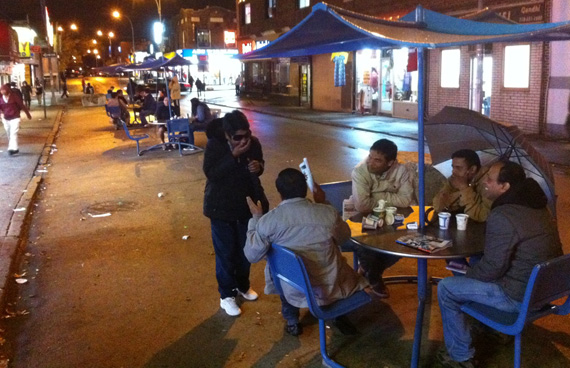The 2011 NYC Streetsies, Part 1
8:00 AM EST on December 28, 2011
The presentation of the 2011 New York City Streetsies kicks off with highlights from the past year. To catch up on the nominees and winners in the people's choice categories, have a look at the voting results.
Best Moment
Streetsblog spent the better part of 2011 covering a half-baked lawsuit. Merit-less though it was, the case against the Prospect Park West bike lane enthralled New York City’s conflict-hungry press corps. The litigants made up their myth about a bike-obsessed transportation commissioner imposing her will over local communities, and they found no shortage of pliable pundits and reporters willing to repeat it.
A lot of the year’s best moments gave the lie to all those stories about bike lanes being jammed down the proverbial throats of New Yorkers.
When supporters of the Prospect Park West bike lane outnumbered opponents 8 to 1 at a March community board hearing, when Council Member Melissa Mark-Viverito cheered the extension of protected bike lanes to her East Harlem district, and when poll after poll showed bike lanes are broadly popular, the truth came out: Most New Yorkers want safer streets for biking.
The votes are in, and the people’s choice for the best moment of 2011 was noteworthy for a few other reasons. When DOT Commissioner Janette Sadik-Khan announced the selection of Alta Bikeshare to operate a public bike system, she described a network of sufficient scale -- 10,000 bikes at 600 stations -- to overcome barriers that keep hundreds of thousands of New Yorkers from bicycling. Live in a fourth-floor walk-up? Not a problem when there are always bikes waiting for you on the street. Your office building won't let you bring your bike inside? Just ride a public bike to the nearest station. With 10,000 bikes available from the Upper West Side to Bed Stuy, New York City would have a bike-share system on par with London and Paris. Nothing else could make bicycling for transportation accessible to such huge numbers of people so quickly.
An announcement, though, is just an announcement, and while the bike-share press event was impeccably executed (hat tip to the go-getter who brought both big business advocate Kathy Wylde and labor champion Dan Cantor to the mic), a lot has to happen before any bike-share stations hit the streets. What gave the bike-share announcement extra weight was the timing.
It came at the end of the whole months-long fracas set off by the politically connected PPW NIMBYs. By going big on bike-share, the city sent a clear signal: The future of New York City's streets won't be hampered by 9 Prospect Park West. It still belongs to people with vision.
Most New Yorkers are glad that's the case.
Best Pedestrian Project
Frederick Law Olmsted and Calvert Vaux designed Grand Army Plaza as a great gateway to Prospect Park, a civic space extending beyond the cramped corner of Flatbush Avenue and what was then Ninth Avenue. Little did they know the advent of the automobile would turn it into a traffic vortex. Within a few generations, Grand Army Plaza made a fitting site for the Brooklyn Death-o-Meter, tallying up all the traffic deaths and injuries in Kings County.
In 2011, NYC DOT’s ingenious additions to the north and south sides of Grand Army Plaza reclaimed this public space for pedestrians. The traffic is still there, but now, especially on the north side, you can walk across it without taking your life in your hands. No more long, circuitous routes scampering from one sad excuse for a pedestrian island to another. The new Grand Army Plaza invites you to walk with dignity.

It's still going to take a lot of work before Grand Army Plaza hosts the variety of activity that would make it a great public space. Already, though, the GAP improvements are a model for local livable streets advocates throughout the city. The project never would have happened without neighborhood champions like the Grand Army Plaza Coalition pressing for change, and DOT staff who listened and weren't afraid to make change happen.
Best Bike Project
The bike network didn’t grow as rapidly in 2011 as it did the previous three years, but this year saw critical new links take shape. The people's choice came down to two worthy segments competing for the title of year's best bike project. In a close vote, the extension of the First and Second Avenue bike lanes up to 57th Street edged out the new Queensboro Bridge approach at Queens Plaza for the honors.

The East Side project, while not very robust on the Second Avenue side, stands apart for a few reasons: 1) It's the first north-south pair of on-street bike lanes that connect to the heart of Midtown; 2) First Avenue now features the first northbound protected bike lane to extend past 34th Street (this explains why 2011 was the first year I biked to Grand Central); and 3) It inspired the...
Best Marcia Kramer Segment
Cross 2011 bikelash hysteria with USA PATRIOT Act-era fearmongering and you get this unholy spawn:
Best Bus Project
With the launch of MTA Bus-Time on the B63 route this February, riders could look up the location of the next bus by sending a text message or checking their smartphones. The MTA struggled for years to deliver information that would take the guesswork out of waiting for the bus. The agency seems to have made a breakthrough with the open source platform that B63 Bus-Time is built on (disclosure: OpenPlans, Streetsblog's parent organization, helped develop the platform). Bus-Time is coming to every route in Staten Island next year, and if all goes well, to every bus route in the city soon thereafter.
Best New Plaza
2011 was a banner year for neighborhood plazas outside Manhattan. In Brooklyn, Clinton Hill and East New York welcomed new public spaces. And in Queens, the city's most park-starved neighborhood, Jackson Heights, got more breathing room with the as-yet-unnamed plaza on 37th Road between 73rd and 74th streets. The nameless Jackson Heights plaza wins the award by virtue of the people's choice votes, the outstanding collaboration between DOT and neighborhood advocates that led to this project, and the fact that it's clearly a big draw at all times of day, no matter the weather:
Best Use of Asphalt
With some new signs, a little thermoplast, and a few asphalt speed humps, NYC DOT made Claremont the city's first neighborhood 20 mph zone. Yes, it could look nicer, but the "slow zone" treatment is low-cost traffic calming that other neighborhoods want for their streets. The more places opt in, the more drivers will get the message: Speed kills.
Best Report
The Hunter College graduate students who wrote "Beyond the Backlash" put together the year's most original research on how cyclists use neighborhood streets and how the bike network serves them (or doesn't). Their report also includes some of the clearest thinking put in print about how DOT can overcome the shortcomings of the current Community Board process to deliver a safer bike network for all New Yorkers.
Most Underappreciated Pedestrian Safety Innovation
New York City's first bike corral turned a loading zone on Smith Street into a dozen bike parking spots. But it's not just a place to store bicycles (although it is an excellent place to do that) -- it's also a great way to improve sightlines for pedestrians and drivers so everyone can see where everyone else is headed. Countless intersections in New York City would be safer if the street corners belonged to bike parking instead of car parking.

Best Grand Opening
From now on, instead of ribbon cuttings, every new public space project should put on a dance party like Putnam Plaza:
Stay in touch
Sign up for our free newsletter
More from Streetsblog New York City
Justice Dept., Citing Streetsblog Reporting, Threatens to Sue NYPD Over Cops’ Sidewalk Parking
The city is now facing a major civil rights suit from the Biden Administration if it doesn't eliminate illegal parking by cops and other city workers.
What to Say When Someone Claims ‘No One Bikes or Walks in Bad Weather’
Yes, sustainable modes are more vulnerable to bad weather. But that's why we should invest more in them — not less.
NYC Transit’s New Operations Planning Chief Wants To Fight ‘Ghost Buses’
One-time transit advocate and current MTA Paratransit VP Chris Pangilinan will oversee bus and subway operations for the whole city.
Friday’s Headlines: Gimme Bus Shelter Edition
The days of the Landmarks Preservation Commission reviewing every proposed bus shelter in landmarked districts may be no more. Plus more news.
Deal Reached: Hochul Says ‘Sammy’s Law’ Will Pass
The bill, though imperfect, has been four years in the making.






